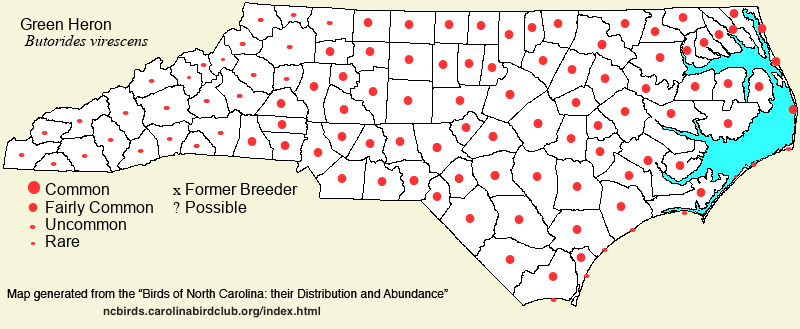 |  |
|
Green Heron - Butorides virescens ARDEIDAE Members: | Search Common: Search Scientific: |
|
|
|||||||
| General Comments | The Green Heron, formerly called the Green-backed Heron (and before that the Green Heron again), is the only wading bird that nests across the entire state, presumably breeding in all 100 counties. Unlike all other herons, egrets, and ibises, this species nests singly, or rarely in loose groups, and because of its solitary habits, nests are not easily found. Thus, this wader would be nearly impossible to gather statewide nesting results. Also, unlike most other waders, Green Herons typically clear out of North Carolina in winter, though there are numerous winter records. It is not unusual to see one on a coastal CBC, though few such birds likely remain through the winter. Green Herons are mostly freshwater inhabitants (and occasionally in brackish water sites), and tend to stay close to wooded cover, such as around the margins of forested lake and pond shores, beaver ponds, and wooded streams. Numbers appear to have declined slightly in recent years, for no obvious reasons. | ||||||
| Breeding Status | Breeder | ||||||
| NC BRC List | Definitive | ||||||
| State Status | |||||||
| U.S. Status | |||||||
| State Rank | S5B | ||||||
| Global Rank | G5 | ||||||
| Coastal Plain | Summer resident and migrant. Fairly common breeder over most of the entire province, though somewhat less numerous on barrier islands. Primarily from late Mar to late Oct; rare through Dec into early Jan, but mostly absent from mid-Jan to late Feb. Peak counts: | ||||||
| Piedmont | Summer resident and migrant. Fairly common breeder over most of the region, though uncommon in the western portions and foothills. Mostly early Apr into Oct. Very rare in winter, with a handful of reports in Dec and early Jan, but essentially absent until late Mar. However, one did spend the entire winter of 2020-21 at Durham. Peak counts: | ||||||
| Mountains | Summer resident and migrant. Generally uncommon breeder, but may be fairly common in low elevations, and rare to absent (at least in the breeding season) over about 3,500 feet. Casual to now very rare in early winter (Dec) at low elevations, with three recent records in Jan, and one in Feb. Peak counts: | ||||||
| Finding Tips |
Though not uncommon in much of the state, it is hard to pinpoint specific places to search for them. They are fairly easily seen around lakes in the Piedmont with a slight muddy shoreline exposed. *** | ||||||
| Attribution | LeGrand[2022-04-26], LeGrand[2021-05-17], LeGrand[2012-05-13] | ||||||
| NC Map Map depicts all counties with a report (transient or resident) for the species. | Click on county for list of all known species. |
| NC Breeding Season Map Map depicts assumed breeding season abundance for the species. |  |